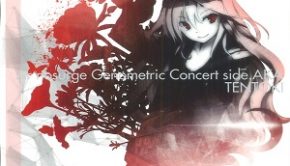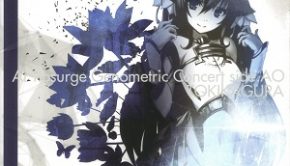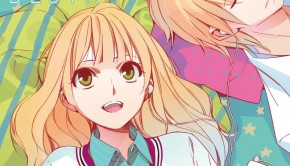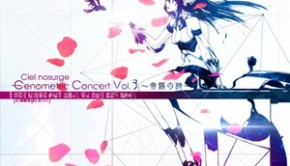Surge Concerto: Ciel nosurge Original Soundtrack -Sound and World Reception Record- Sec. 2
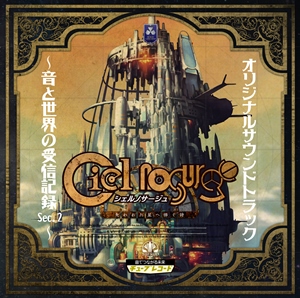 |
Album Title: Ciel nosurge Original Soundtrack -Sound and World Reception Record- Sec. 2 |
| Record Label: KOEI Tecmo Games |
|
| Catalog No.: KECH-8001/2 |
|
| Release Date: October 1, 2014 |
|
| Purchase: Buy at CDJapan |
Overview
After a two year-long run, Ciel nosurge finally came to its end with the release of its twelfth and final chapter at the end of July 2014. And just a few months later, the duet of final albums that cover the rest of its music were released, with the instrumental soundtrack containing two discs filled with pieces composed by the same artists that made the first soundtrack, Akiko Shikata and an artist known by the pseudonym SSS. It also includes melodies made by Yu Shimoda, Kazuki Yanagawa, Ryudai Abe and Hayato Asano. However, how does this soundtrack fare in comparison to the first volume? And does it accomplish its role properly?
Body
First, I’d advise having read the review for the Ciel nosurge Genometric Concert Vol. 1 -Pact Songs- album in order to get an introduction to the world of Ra Ciela, given that I’ll be referring constantly to terminology used in the game in order to get across the situations in which several of the pieces are used. That said, I can confirm that this soundtrack volume follows in the footsteps of its predecessor, as most of the pieces follow the electronica, choral and ethnic sound that permeated it. Akiko Shikata does most of the compositional work this time around, though it feels like a small downgrade in quality because all of the instrumentation is synthesized this time around.
The first portion of the soundtrack is dedicated to the map themes used in Ciel nosurge‘s later chapters. “Almetica March” is used as the map theme for Ciel nosurge’s fifth chapter set in the information city Almetica. A good example of the ethnic sound permeating through the score is the first track in the album, it’s a simplistic march featuring novelty instruments such as bagpipes, whistle, and bouzouki. While a decent listen, I have to say it’s a bit strange to have a piece that wouldn’t sound out of place in a renaissance fair representing a technologically advanced city that serves like a gigantic library to the world of Ra Ciela. Two stronger pieces include “ImitationRED” and “Festival for the Lofty Souls” for the seventh and eighth chapters. The former is a purely electronica piece featuring distorted vocals sung by Shikata herself, while the latter is a progressive rock piece. Suffice to say that the first conveys the feelings of desolation and abandonment present in the ruined laboratories, as well as giving something of a bad feeling to the listener; while the latter conveys the urgency of a world that has no hope of salvation and that is about to get destroyed at any moment.
Some tracks offer a much-needed dose of calm. “White Cherry Blossom Park”, on the other hand, is a playful piano-infused electronic piece ideal for representing the setting of Ciel nosurge’s sixth chapter: Colon Four Seasons, where the richest people of Ra Ciela live. Another, “Nyurorestaurant”, is a cutesy piece featuring music box and comedic sounds with Shikata’s vocals, which near the end turns into something that could perfectly fit a ghost house due to the addition of a ghastly laughter and an organ. It’s certainly befitting for the Palace Nyurokeel amusement park, the largest amusement park built in Ra Ciela. “Miniature Garden Before the Departure” is a calm piano piece with some electronica and techno elements on it. This one, composed by Kazuki Yanagawa, is the theme for the location where the tenth chapter takes place: Colony Ship Soreil.
We return to the darkness with the eleven chapter theme, “LastPandemic”, which happens to be the Imperial Palace where Ra Ciela’s Empress lives. Once again, it’s electronica with Shikata’s voice over it, but unlike ImitationRED, it has a more upsetting sound and has a much more frantic rhythm. In general it conveys a great sense of despair, which makes perfect sense storyline-wise, as chapter 11 is the one that shows the events that led to Ra Ciela’s final demise. And finishing off the map screen themes, we come across “Horizon of a Starry Sky”, which is the theme for the Singing Hill space station that serves as the setting for the final chapter. While it’s a variation of the piece “Horizon” from Ar nosurge: Ode to an Unborn Star, this one has a faster rhythm and replaces a good part of the electronic sounds with a chorus and a percussion set, giving off the feeling of traveling to space and seeing the stars all around. It’s also the second and last contribution Kazuki Yanagawa made to the album.
Next, we have the new Dive Gate themes, “Dwelling of Illusions” and “Dwelling of Principles”. . These replace the song “Dwelling of Dreams” from the first volume when the player starts the Downfall Arc and the Empress Arc in Ciel nosurge’s story respectively. Both songs have the same base melody, with the former having a soft arrangement consisting of woodwinds, strings, and bouzouki, while the latter speeds up the song’s rhythm, adds Shikata’s voice. and a full orchestra. While they both share the use of a music box and have similar openings, the latter also has a brief introduction section made out from Shikata’s singing, and they show how the atmosphere of the game changes at the storyline progresses: Illusions tells the player they’ve gotten used to being with Ion but that the true tests are about the begin, while Principles announces they have reached the climax and that the story is about to show its heaviest moments.
The rest of the tracks on the disc, sans for the last four, are all event themes. “Conflagration Sketched by the Winds” plays during critical moments such as when Ion begins to recall particularly traumatic memories near the end of the game; and is composed by sweeping piano passages and frantic winds. “The Great Wheel of Fate” has a more Japanese ceremonial tone to it between Shikata’s chanting, while the conversation theme “The Mailbox of Ms. Yuuki” is a low-key synthetic track. We also have the sentimental and sorrowful music box arrangement of “Promise” from the first volume, titled “Promise -Gentle Tears-”. However, I have to question the inclusion of “Introductory Resonance -Ritual Prayer-”, as it is identical in all aspects to the version recorded in the Vol. 1 soundtrack, except for lacking the elevator sounds at the beginning. It’s among said event themes that we can also find the two contributions SSS made to the soundtrack: “Poppekepe~?” and “Final Feelings”. The former is a comical fast-paced synth piece that includes some samba elements, while the latter is similar to a piece they made for the Vol.1 soundtrack called “HACK=MAGIC”. Word of caution though: “Final Feelings” and another piece titled “00:00:01” got their titles and track order mixed up in the physical release of the album with “Dwelling of Illusions” and “Dwelling of Principles”. This should be taken in account in case they sound dissimilar from the description given here.
Next, we come to Yu Shimoda’s contributions for the soundtrack, which despite being in the game ever since it was released, didn’t feature officially in any albums until now. They are the “Sound Diary” songs: “A Mysterious House”, “Nap Coefficient”, “Moon Paper Lamp”, and “The Red Star”. They are all soft piano and synth ambient pieces that can be heard at varying points in the segments where the player interacts with Ion, which is the main part of the game. I have to say they are a very relaxing listen and surely they work wonders in context inside the game due to the player focusing more on what Ion says and does than on the music, but they end up being too repetitive as a stand-alone listen due to the sheer length of each loop and the fact that these four songs last five minutes each.
Next, we have the second disc. With a playtime of just 25 minutes, this is entirely made of unreleased pieces created for Ciel nosurge, three composed by Ryudai Abe and the rest by Hayato Asano. The first of Abe’s pieces is “Prim Nosurge”, a beautiful song that starts with some flute and vocals from UYU and Mitsuki Nakae, before picking up in speed into a nice, energetic mix of flute, guitar, piano, strings and vocals. The same could be said for “The Legend of Sharlanoia”, with the difference that the piece is energetic all the way through from beginning to end. “Land of Hope – Honokano” emerges into a softer and calmer version of “Prim Nosurge”; while a decent listen, I feel it needed more to differentiate it as it sounds at some points as if I was listening to two different versions of the same song due to the reuse of instrumentation and melodies. However, given how “Land of Hope – Honokano” ends, it might just be that they intended these songs to be like a story divided in three parts.
Next, we begin with the pieces composed by Hayano Asato, the first of which is titled “Rhythm Signs”. I have to say it feels like a more developed version of “Miniature Garden Before the Departure” due to the addition of cello and violin lines, though the melody is different enough to not confuse them. On the other hand, “Ephemeral Feelings” doesn’t really go anywhere despite its faster pace, as the melody just flows but doesn’t actually develop in any significant way before fading away. Also disappointing are the downbeat piano-based track “First Destruction Kalpa” and the similarly-styled “Obedient Current Shadows”, which lack the substance of the tracks of the first volume. The next piece in the list is titled “niizhtana” (“20” in Ojibwe language), a synth piece with some pizzicato and guitar, which unfortunately suffers from being too short: just as the song sounds like it begins developing into something, it loops back to the beginning and fades away. Like several of these unused tracks, it seems like there were some interesting ideas behind it, but they never came to fruition.
And finishing the disc, we have the “Story” series: three pieces titled “First Story”, which are subtitled “bezhig”, “niizh” and “niswi” (“one”, “two” and “three” in Ojibwe language), and one titled “Another Story”. I can say that “First Story –bezhig-” is a synth, flute, violin and guitar piece that would have sounded perfect in funny situations either in Ciel nosurge and Ar nosurge, and it’s a nice listen on its own. However, I can’t say the same thing about “First Story –niizh-” and “First Story –niswi-” for the simple reason they are pretty much copies of each other; the only difference they have with “bezhig ” is that they are edits that omit the first 30 seconds from it and change a bit the instrumentation. However, “Another Story” uses the base structure and melody of “niizh” and goes in its own direction, being a soothing bass, synth and piano piece that comes off as a relief from hearing the same song three times in a row, though unfortunately, it’s too short and ends after just a minute.
And while this is where the physical album would end, those who preordered its digital version from the Japanese iTunes store were also treated to one additional song that was actually used in the game: it’s titled “Ciel Nosurge”, just like the game, and it could be heard in the title screen after the player had advanced enough to clear chapter 6. It’s a vocal piece by Akiko Shikata with lyrics in REON-4213 taken partly from “QuelI->{ein te hyme}’”. It builds up quite quickly and crescendos in an impressive ending. Its only fault is being less than a minute short, but it’s still an excellent piece. And as a side-note, it can be downloaded in WAV format by those that have a MyGustID account in Gust’s social site and answer a questionnaire about the album.
Summary
While the second Ciel nosurge soundtrack has more discs, and in turn a larger amount of music, I have to say it’s a bit of a mixed bag. The first disc is mostly excellent, though Shikata didn’t fully develop some of the pieces (e.g. “Alien Road” or “Personality Collapse Project”). The second disc varies too much in quality due to a lot of repetitive tracks and Asano’s work being somewhat inconsistent in tone and quality. Additionally, I’m a bit sad about the fact that “Ciel Nosurge” isn’t present in the physical release and that next to none of the tracks featured real instruments… However, most of the rest of Shikata’s work is stellar, as also are the contributions made by Yanagawa, Shimoda, SSS and Abe. I can only say this album is a worthwhile recommendation to anyone who likes the music from Ar tonelico or Surge Concerto. It continues employing the foundations from it alongside the elements that were added in the first soundtrack, though doesn’t quite live up to the quality or quantity of the first Ciel nosurge soundtrack or the Ar nosurge album.
Do you agree with the review and score? Let us know in the comments below!
3.5
Posted on August 16, 2015 by Gerardo Iuliani. Last modified on January 19, 2016.

